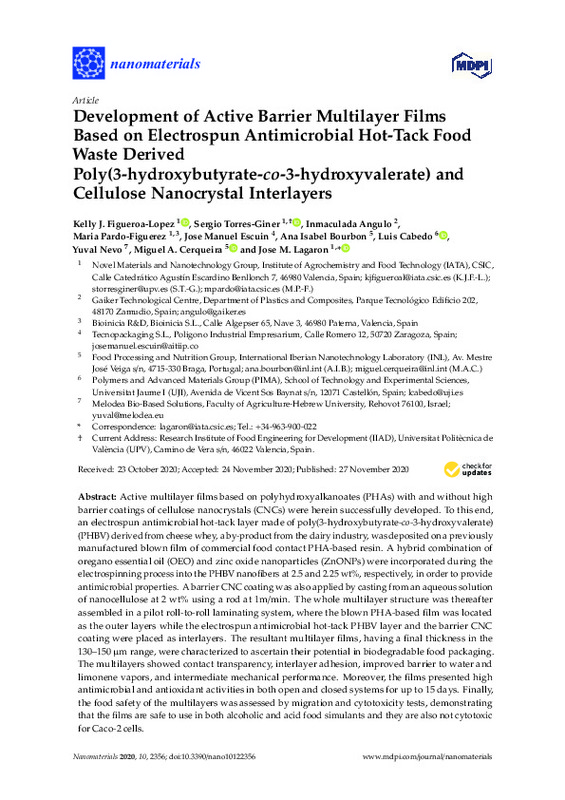JavaScript is disabled for your browser. Some features of this site may not work without it.
Buscar en RiuNet
Listar
Mi cuenta
Estadísticas
Ayuda RiuNet
Admin. UPV
Development of Active Barrier Multilayer Films Based on Electrospun Antimicrobial Hot-Tack Food Waste Derived Poly(3-hydroxybutyrate-co-3-hydroxyvalerate) and Cellulose Nanocrystal Interlayers
Mostrar el registro sencillo del ítem
Ficheros en el ítem
| dc.contributor.author | Figueroa-Lopez, Kelly J.
|
es_ES |
| dc.contributor.author | Torres-Giner, Sergio
|
es_ES |
| dc.contributor.author | Angulo, Inmaculada
|
es_ES |
| dc.contributor.author | Pardo-Figuerez, Maria
|
es_ES |
| dc.contributor.author | Escuin, Jose Manuel
|
es_ES |
| dc.contributor.author | Bourbon, Ana Isabel
|
es_ES |
| dc.contributor.author | Cabedo, Luis
|
es_ES |
| dc.contributor.author | Nevo, Yuval
|
es_ES |
| dc.contributor.author | Cerqueira, Miguel A.
|
es_ES |
| dc.contributor.author | Lagaron, Jose M.
|
es_ES |
| dc.date.accessioned | 2021-11-05T14:10:22Z | |
| dc.date.available | 2021-11-05T14:10:22Z | |
| dc.date.issued | 2020-12 | es_ES |
| dc.identifier.uri | http://hdl.handle.net/10251/176411 | |
| dc.description.abstract | [EN] Active multilayer films based on polyhydroxyalkanoates (PHAs) with and without high barrier coatings of cellulose nanocrystals (CNCs) were herein successfully developed. To this end, an electrospun antimicrobial hot-tack layer made of poly(3-hydroxybutyrate-co-3-hydroxyvalerate) (PHBV) derived from cheese whey, a by-product from the dairy industry, was deposited on a previously manufactured blown film of commercial food contact PHA-based resin. A hybrid combination of oregano essential oil (OEO) and zinc oxide nanoparticles (ZnONPs) were incorporated during the electrospinning process into the PHBV nanofibers at 2.5 and 2.25 wt%, respectively, in order to provide antimicrobial properties. A barrier CNC coating was also applied by casting from an aqueous solution of nanocellulose at 2 wt% using a rod at 1m/min. The whole multilayer structure was thereafter assembled in a pilot roll-to-roll laminating system, where the blown PHA-based film was located as the outer layers while the electrospun antimicrobial hot-tack PHBV layer and the barrier CNC coating were placed as interlayers. The resultant multilayer films, having a final thickness in the 130-150 mu m range, were characterized to ascertain their potential in biodegradable food packaging. The multilayers showed contact transparency, interlayer adhesion, improved barrier to water and limonene vapors, and intermediate mechanical performance. Moreover, the films presented high antimicrobial and antioxidant activities in both open and closed systems for up to 15 days. Finally, the food safety of the multilayers was assessed by migration and cytotoxicity tests, demonstrating that the films are safe to use in both alcoholic and acid food simulants and they are also not cytotoxic for Caco-2 cells. | es_ES |
| dc.description.sponsorship | The Spanish Ministry of Science and Innovation (MICI) through the RTI2018-097249-B-C21 program number and the EU H2020 YPACK (reference number 773872) projects funded this research. | es_ES |
| dc.language | Inglés | es_ES |
| dc.publisher | MDPI AG | es_ES |
| dc.relation.ispartof | Nanomaterials | es_ES |
| dc.rights | Reconocimiento (by) | es_ES |
| dc.subject | PHBV | es_ES |
| dc.subject | Nanocellulose | es_ES |
| dc.subject | Multilayers | es_ES |
| dc.subject | Oregano essential oil | es_ES |
| dc.subject | Zinc nanoparticles | es_ES |
| dc.subject | Barrier films | es_ES |
| dc.subject | Active packaging | es_ES |
| dc.subject | Migration | es_ES |
| dc.subject | Cytotoxicity | es_ES |
| dc.subject.classification | TECNOLOGIA DE ALIMENTOS | es_ES |
| dc.title | Development of Active Barrier Multilayer Films Based on Electrospun Antimicrobial Hot-Tack Food Waste Derived Poly(3-hydroxybutyrate-co-3-hydroxyvalerate) and Cellulose Nanocrystal Interlayers | es_ES |
| dc.type | Artículo | es_ES |
| dc.identifier.doi | 10.3390/nano10122356 | es_ES |
| dc.relation.projectID | info:eu-repo/grantAgreement/EC/H2020/773872/EU/HIGH PERFORMANCE POLYHYDROXYALKANOATES BASED PACKAGING TO MINIMISE FOOD WASTE/ | es_ES |
| dc.relation.projectID | info:eu-repo/grantAgreement/Agencia Estatal de Investigación//IJCI-2016-29675//AYUDA CONTRATO JUAN DE LA CIERVA-INCORPORACION-TORRES GINER/ | es_ES |
| dc.relation.projectID | info:eu-repo/grantAgreement/AEI//RTI2018-097249-B-C21//ENVASE ACTIVO MULTICAPA TERMOCONFORMABLE DE ALTA BARRERA BASADO EN BIOECONOMIA CIRCULAR/ | es_ES |
| dc.rights.accessRights | Abierto | es_ES |
| dc.contributor.affiliation | Universitat Politècnica de València. Departamento de Tecnología de Alimentos - Departament de Tecnologia d'Aliments | es_ES |
| dc.description.bibliographicCitation | Figueroa-Lopez, KJ.; Torres-Giner, S.; Angulo, I.; Pardo-Figuerez, M.; Escuin, JM.; Bourbon, AI.; Cabedo, L.... (2020). Development of Active Barrier Multilayer Films Based on Electrospun Antimicrobial Hot-Tack Food Waste Derived Poly(3-hydroxybutyrate-co-3-hydroxyvalerate) and Cellulose Nanocrystal Interlayers. Nanomaterials. 10(12):1-24. https://doi.org/10.3390/nano10122356 | es_ES |
| dc.description.accrualMethod | S | es_ES |
| dc.relation.publisherversion | https://doi.org/10.3390/nano10122356 | es_ES |
| dc.description.upvformatpinicio | 1 | es_ES |
| dc.description.upvformatpfin | 24 | es_ES |
| dc.type.version | info:eu-repo/semantics/publishedVersion | es_ES |
| dc.description.volume | 10 | es_ES |
| dc.description.issue | 12 | es_ES |
| dc.identifier.eissn | 2079-4991 | es_ES |
| dc.identifier.pmid | 33260904 | es_ES |
| dc.identifier.pmcid | PMC7761208 | es_ES |
| dc.relation.pasarela | S\427096 | es_ES |
| dc.contributor.funder | European Commission | es_ES |
| dc.contributor.funder | Agencia Estatal de Investigación | es_ES |








